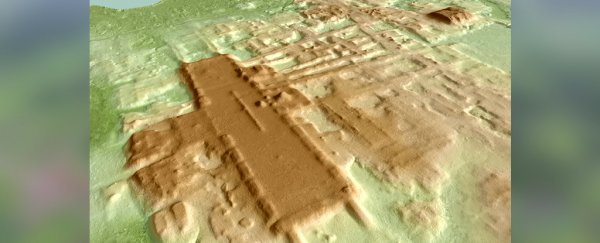A giant, sprawling structure almost a mile long has been discovered at the southern tip of Mexico, with researchers saying it may represent the oldest and largest monument of the ancient Maya civilisation ever found.
The site, called Aguada Fénix, is located in the state of Tabasco, at the base of the Gulf of Mexico. It's so vast for its age, the find is making archaeologists recalibrate their timelines on the architectural capabilities of the mysterious Maya.
Before now, the Maya site of Ceibal (aka Seibal) was thought to be the oldest ceremonial centre, dating back to around 950 BCE.
Aguada Fénix, which measures over 1,400 metres (almost 4,600 ft) in length at its greatest extent, dates to a similar timeframe, with researchers estimating it was built between 1000 and 800 BCE – but its immense size and scope make it unlike anything found before from the period.
 3D image of the site of Aguada Fenix based on LIDAR. (Takeshi Inomata)
3D image of the site of Aguada Fenix based on LIDAR. (Takeshi Inomata)
"To our knowledge, this is the oldest monumental construction ever found in the Maya area and the largest in the entire pre-Hispanic history of the region," the researchers, led by archaeologist Takeshi Inomata from the University of Arizona, explain in a new paper about the discovery.
What's even more staggering is that this huge, unknown structure has actually been hiding in plain sight for centuries, seemingly unrecognised by the modern Mexicans living their lives on top of the vast complex.
"This area is developed," Inomata says. "It's not the jungle; people live there. But this site was not known because it is so flat and huge. It just looks like a natural landscape."
Despite Aguada Fénix's inconspicuousness, it can't hide from non-human eyes. Aerial surveys using LIDAR detected the anomaly, revealing an elevated platform measuring 1,413 metres north to south, and 399 metres east to west, and extending up to 15 metres above the surrounding area.
"Artificial plateaus may be characterised as horizontal monumentality, which contrasts with the vertical dimensions of pyramids," the authors write, noting the layout of Aguada Fénix marks it as an example of the Middle Formative Usumacinta (MFU) pattern, characterised by a rectangular shape defined by rows of low mounds.
Nine wide causeways extend from the platform, which is also surrounded by a number of smaller structures, including smaller MFU complexes and artificial reservoirs.
 Aerial view of Aguada Fénix. (Takeshi Inomata)
Aerial view of Aguada Fénix. (Takeshi Inomata)
The site bears certain similarities to the Olmec sites San Lorenzo and La Venta in the nearby state of Veracruz, but Aguada Fénix's lack of human-shaped statues could provide a clue about the ancient Maya that inhabited this complex, distinguishing them from the Olmec.
"Unlike those Olmec centres, Aguada Fénix does not exhibit clear indicators of marked social inequality, such as sculptures representing high-status individuals," the authors write.
"The only stone sculpture found so far at Aguada Fénix depicts an animal."
If the researchers are right about that, the site could be hugely important in helping us understand more about how these enigmatic human societies functioned and organised themselves – especially if they embraced a communal form of societal structure that rejected hierarchical forms.
"This kind of understanding gives us important implications about human capability, and the potential of human groups," Inomata says.
"You may not necessarily need a well-organised government to carry out these kinds of huge projects. People can work together to achieve amazing results."
The findings are reported in Nature.
